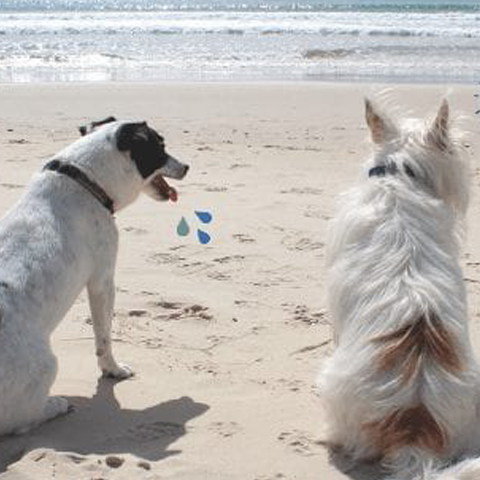Now that summer seems to have returned to our sceptre isle (fingers crossed), our thoughts turn to fun days out at the beach. There’s nothing like sea air to blow away the cobwebs, energise the soul, and leave a healthy, rosy glow on the cheeks.
Many dogs love a day at the beach too, and every year many of us head to the seaside to enjoy a day with dog in tow. If you are considering joining the bucket and spade brigade this summer with your pet, read on to discover NHHQ top tips for keeping your dog happy and safe, whilst ensuring that the whole family has a great time being beside the seaside, beside the sea!
Do your research
There are restrictions on some beaches and beach resorts regarding dogs: whether they are welcome, whether they need to be kept on a lead etc. Some beaches have seasonal restrictions, with fewer regulations out of peak summer, and some beaches only allowing dogs in the winter months when they are less busy. To avoid disappointment, and a very miserable drive home, we recommend that you check the beach in advance, and the area around, to ensure that you and your hound will be welcome. Here at NHHQ in Norfolk, our favourite dog-friendly local beach is Old Hunstanton because it is dog friendly all year round and has miles of sandy beach for your pup (and you) to enjoy.
Dog safety
Just like with the ankle-biters at the beach, it is always important to keep a close eye on safety when it comes to the dog. Stop them from picking up and chomping down any of the random rubbish that they might find on the sand – all sorts gets washed up on beaches and you really don’t want a trip to the vets instead of the fish and chip shop at the end of the day. Also, sand fleas can be an issue on beaches and are keen on attaching themselves onto dogs so make sure your pet has a good flea collar or is protected by a suitable flea treatment. Keep an eye out too for sharp objects in the sand like broken glass or shells that may cut skin or feet. Don’t forget to check your dog before heading home for any small injuries or little nicks in the paws.
If you are blessed with good weather (fingers crossed again…we are crossing our fingers so much these days, it is making it quite difficult to type blogs), do make sure that you find or bring some shade for your pet so that they do not get over-heated. If the weather is fresher (let’s be honest, this advice will probably be more applicable, sigh) then do keep an eye on the pooch that they don’t get too cold – particularly if they are in and out the sea. Whether hot or cold, if the sun is out you might have to apply sunscreen to your dog’s extremities if they are prone to sunburn.
Hydrate before you elongate
Before stretching yourself out on the sand to soak up the rays – or lying weeping under cover of the streaking rain and wind – make sure that you have plenty of fresh water to hand. Same goes for the dog – take a bowl and a bottle of fresh water. Your dog may well have a lap or two of the salty sea water while at the beach, so will be even more in need of a good watering throughout the day. Fresh water taps are often provided at the carparking area of beaches, but best be on the safe side and bring a big bottle from home too.
Be sporty
A day at the beach is a great way of avoiding a session at the gym. Take toys and games with you – bats and balls, frisbees etc and get the whole family running around. Floating toys are also good for retrieving in the sea if your dog is a strong swimmer. Don’t forget to rinse them off at the end of the day though as salt water can corrode pretty fast through many toys, and may also contain pollutants or chemicals that will upset your dog’s tum if ingested.
Pick up the Poo
When on a day at the beach, just as when in any other public place, it is essential that you clean up after you dog. Bag the poo and dispose of it in the appropriate dog waste bins. Generally, dog-friendly beaches will have plenty of them around, but you may have to take your bags home with you for disposal (so take plenty of bags to double or triple bag the poop for the trip home. Nothing puts you off your homeward journey 99 flake than a general odour of doggy do emanating from the boot). While on your day out be sure to obey all signage regarding where you can and cannot take your dog, and if they need to be kept on a lead.
As a final note….
Can your canine do the doggy paddle? It does seem a strange question, but although all dogs can swim in theory, some are not so keen. Some breeds are not as strong swimmers because of their physiognomy – bulldogs for example have heavy heads in relation to their bodies which makes it tough for them to swim effectively. Other dogs with short faces may have issues in terms of being able to keep their noses out the water. Never force a dog to swim if they don’t want to.
If your dog is a swimmer, and even the Duncan Goodhew of dogs (why can’t NHHQ think of a more recent swimmer than that? Really showing our age today here…) do remember that the sea is not like the local pond. Tides and currents can have huge effects on their ability to stay safe. Check the details before swimming and never allow dogs to swim in areas that aren’t safe for humans to swim in, and if they do swim – keep an eye on them at all times.
Before heading home…
When it is time to head home make sure you offer your dog water and allow them time to cool off if they have been darting about on the beach like a mad thing. Rinse yourself and your dog with fresh water to wash off the saltwater, sand and any pollutants. When you get home we suggest that everyone has a bath (perhaps not all together) to make sure that all debris is washed from fur (dogs’, not yours) and so everyone can have a good itch-free sleep. Nothing like a sleep after a day at the beach – sweet dreams all!







